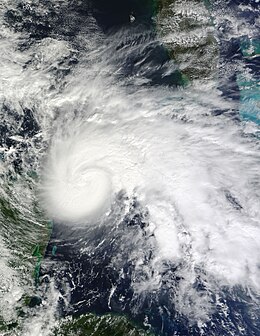Hurricane Ida (2009)
| Category 2 hurricane (SSHWS/NWS) | |

Hurricane Ida near peak intensity in the Yucatán Channel on November 8
|
|
| Formed | November 4, 2009 |
|---|---|
| Dissipated | November 10, 2009 |
| Highest winds |
1-minute sustained: 105 mph (165 km/h) |
| Lowest pressure | 975 mbar (hPa); 28.79 inHg |
| Fatalities | 4 direct |
| Damage | $11.3 million (2009 USD) |
| Areas affected | Central America, Cayman Islands, Yucatán Peninsula, Cuba, Southeastern United States, Mid-Atlantic states, New England, Atlantic Canada |
| Part of the 2009 Atlantic hurricane season | |
Hurricane Ida was the strongest landfalling tropical cyclone during the 2009 Atlantic hurricane season, crossing the coastline of Nicaragua with winds of 80 mph (130 km/h). The remnants of the storm became a powerful nor'easter that caused widespread damage along coastal areas of the Mid-Atlantic States. Ida formed on November 4 in the southwestern Caribbean, and within 24 hours struck the Nicaragua coast with winds of 80 mph (130 km/h). It weakened significantly over land, although it restrengthened in the Yucatán Channel to peak winds of 105 mph (165 km/h). Hurricane Ida weakened and became an extratropical cyclone in the northern Gulf of Mexico before spreading across the southeastern United States. The remnants of Ida contributed to the formation of a nor'easter that significantly affected the eastern coast of the United States.
Numerous watches and warnings were issued during the hurricane's existence. Areas from Panama to Maine were affected by either the storm or the nor'easter low. In Nicaragua, nearly 3,000 people evacuated coastal areas ahead of the storm. More extensive evacuations in Mexico relocated over 100,000 residents and tourists. In the United States, several parishes in Louisiana and counties in Alabama and Florida declared a state of emergency because of fear of significant damage from the storm. Officials issued voluntary evacuations and most schools and non-emergency offices in the region closed.
In Central America, Ida brought heavy rainfall to parts of Costa Rica, Nicaragua and Honduras. Several people were reported missing in Nicaragua, however post-storm reports denied these claims. Thousands of buildings collapsed or sustained damage and roughly 40,000 people were left homeless. Damages from Ida in Nicaragua amounted to at least 46 million córdoba ($2.12 million US$). Aside from heavy rainfall in Mexico and Cuba, little impact from Ida was reported in either country. In the United States, the remnants caused substantial damage, mainly in the Mid-Atlantic States. One person was killed by Ida after drowning in rough seas, while six others lost their lives in various incidents related to the nor'easter. Widespread heavy rainfall led to numerous reports of flash flooding in areas from Mississippi to Maine. Overall, the two systems caused nearly $300 million in damage throughout the country.
...
Wikipedia
